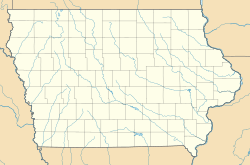South Jordan Cemetery facts for kids
Quick facts for kids |
|
|
South Jordan Cemetery
|
|
| Location | 33928 260th St. |
|---|---|
| Nearest city | Moorhead, Iowa |
| NRHP reference No. | 100006221 |
| Added to NRHP | March 5, 2021 |
The South Jordan Cemetery, also known as the Black Cemetery or the Negro Cemetery, is a special historical place near Moorhead, Iowa in Monona County, Iowa, United States. It was added to the National Register of Historic Places in 2021. This means it's an important site recognized for its history.
Contents
What Makes South Jordan Cemetery Special?
This cemetery is where about twenty people are buried. Most of them were African American. It was unusual for many Black families to live in rural Iowa during that time.
Why Did People Come to Iowa?
There are a couple of ideas about how African Americans came to this part of western Iowa. One old story says they were formerly enslaved people who traveled using the Underground Railroad. However, this settlement happened after the American Civil War, so that story is probably not true.
Another idea is that they were "Exodusters". These were African Americans who moved from the American South after the Civil War. They first settled in Kansas before moving to Nebraska and then into Iowa.
What we do know is that these families came to work for a man named Adam Miers. He was from Ohio and settled in the area in 1856.
Life in Monona County
Even though the African American families mostly kept to themselves, not everyone in the area welcomed them. Some people from a nearby place called Belvidere, which is now a ghost town, even asked the court to make the African Americans leave.
The number of Black residents in Monona County changed over time. In the 1880s, there were 88 Black people. This number dropped to 23 in the 1890s, then to six in 1900, and by 1910, there were none. It's possible that many moved to Sioux City to find work in the factories there.
About the Graves
Most of the 20 burials in the cemetery happened between the early 1880s and 1907. One person, a Caucasian woman, was buried there much later in 1988.
Both of Adam Miers' wives are buried in the cemetery. His first wife, Elizabeth, was Caucasian. His second wife, Mariah, is believed to have been a woman of color. We don't know where Adam Miers himself is buried, but it's possible he is also there.
Only about half of the graves have markers. Some of these markers are hard to read because the writing has faded. A few decades ago, some of the markers were damaged by vandals.



